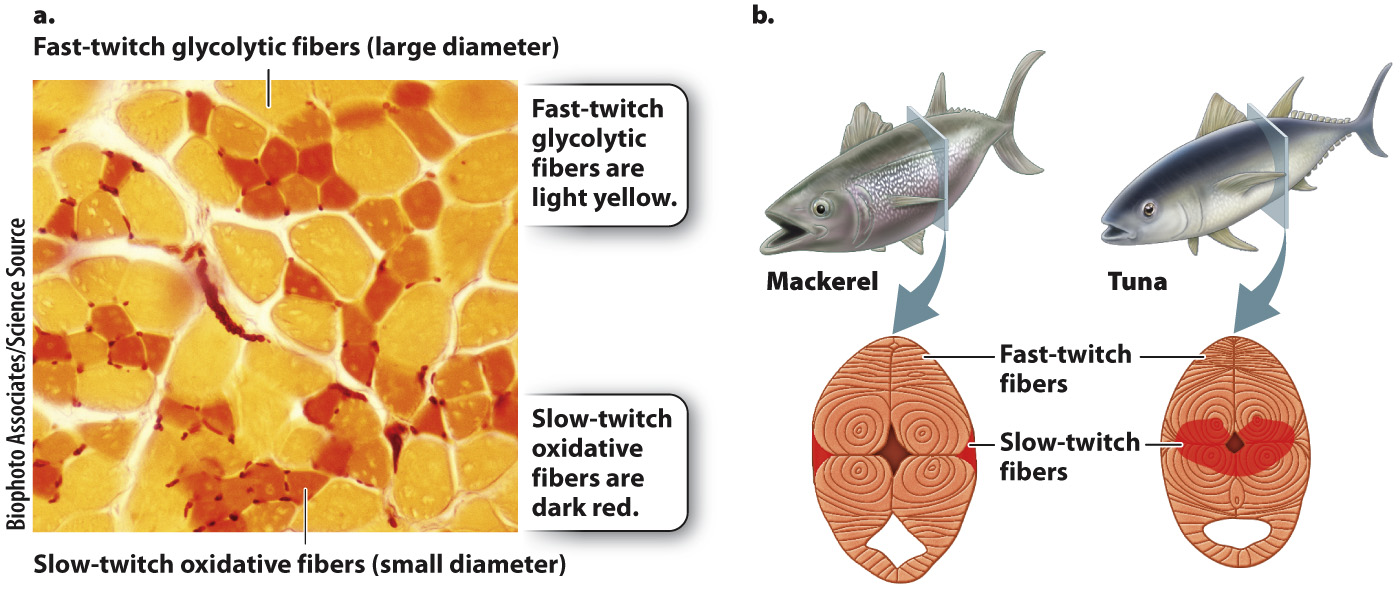Skeletal muscles have slow-twitch and fast-twitch fibers.
The difference between a sprinter and a marathoner is not just training, but also the properties of their muscles. There are different types of muscle fiber (Fig. 37.14), allowing variation in the way muscles contract. In vertebrates, these are most simply classified as red slow-twitch fibers and white fast-twitch fibers (Fig. 37.14a). Slow-twitch fibers are found in muscles that contract slowly and consume ATP more slowly to produce force. An animal uses slow-twitch fibers to control its posture or move slowly and economically. Fast-twitch fibers generate force quickly, producing rapid movements, but they consume ATP more quickly. An animal depends on fast-twitch fibers to sprint or lunge at its prey. A key difference between the two types of fiber is that slow-twitch fibers obtain their energy through oxidative phosphorylation (aerobic respiration), and fast-twitch fibers obtain their energy mainly through glycolysis (Chapter 7).

FIG. 37.14 Slow-twitch (darkly stained) and fast-twitch (lightly stained) skeletal muscle fibers. These two types of fiber provide differences in endurance and the speed of contraction. (a) Mammalian limb muscle; (b) muscles of two different fish species.
Although slow-twitch fibers develop force more slowly, they have greater resistance to fatigue in response to repetitive stimulation—that is, their loss of force over time is less. Their greater endurance is explained by the ability of their mitochondria to supply ATP to muscle fibers by aerobic respiration. Slow-twitch fibers have many mitochondria and are well supplied by capillaries. They contain an abundance of myoglobin, an oxygen-binding protein related to hemoglobin that facilitates oxygen delivery to the mitochondria (Chapter 39). The iron in myoglobin gives muscles with these fibers their red appearance. Slow-twitch muscle fibers express a chemically “slow” form of myosin with a relatively low rate of ATP hydrolysis, limiting their speed of cross-bridge cycling and force development.
White fast-twitch muscle fibers have fewer mitochondria and capillaries, contain little myoglobin, and rely heavily on glycolysis to produce ATP. Fast-twitch fibers express a chemically “fast” form of myosin with a high rate of ATP hydrolysis, favoring rapid force development and movement. However, fast-twitch fibers also fatigue quickly. Because white fibers are larger than red fibers, they generate more force. In general, most skeletal muscles are composed of mixed populations of red and white fiber types, providing a broad range of contractile function.
Athletes who have more oxidative slow-twitch fibers excel at endurance and long-distance competitions. In contrast, athletes who have larger numbers of fast-twitch fibers perform better in sprint races and weight-lifting competitions. Because the distribution and properties of muscle fiber types are strongly inherited, it is largely true that champions are born and not made. Nevertheless, aerobic training can significantly increase the energy output through oxidative phosphorylation of an individual’s muscle fibers, just as weight lifting and speed training can enhance an individual’s strength and sprinting ability. Contrary to popular belief that weight lifting builds muscle by straining the muscle to build new fibers, it actually builds muscle by increasing the size of existing muscle fibers through the synthesis of additional myosin and actin filaments. This synthesis increases the cross-sectional area of the fiber and thus its force-generating capacity.
